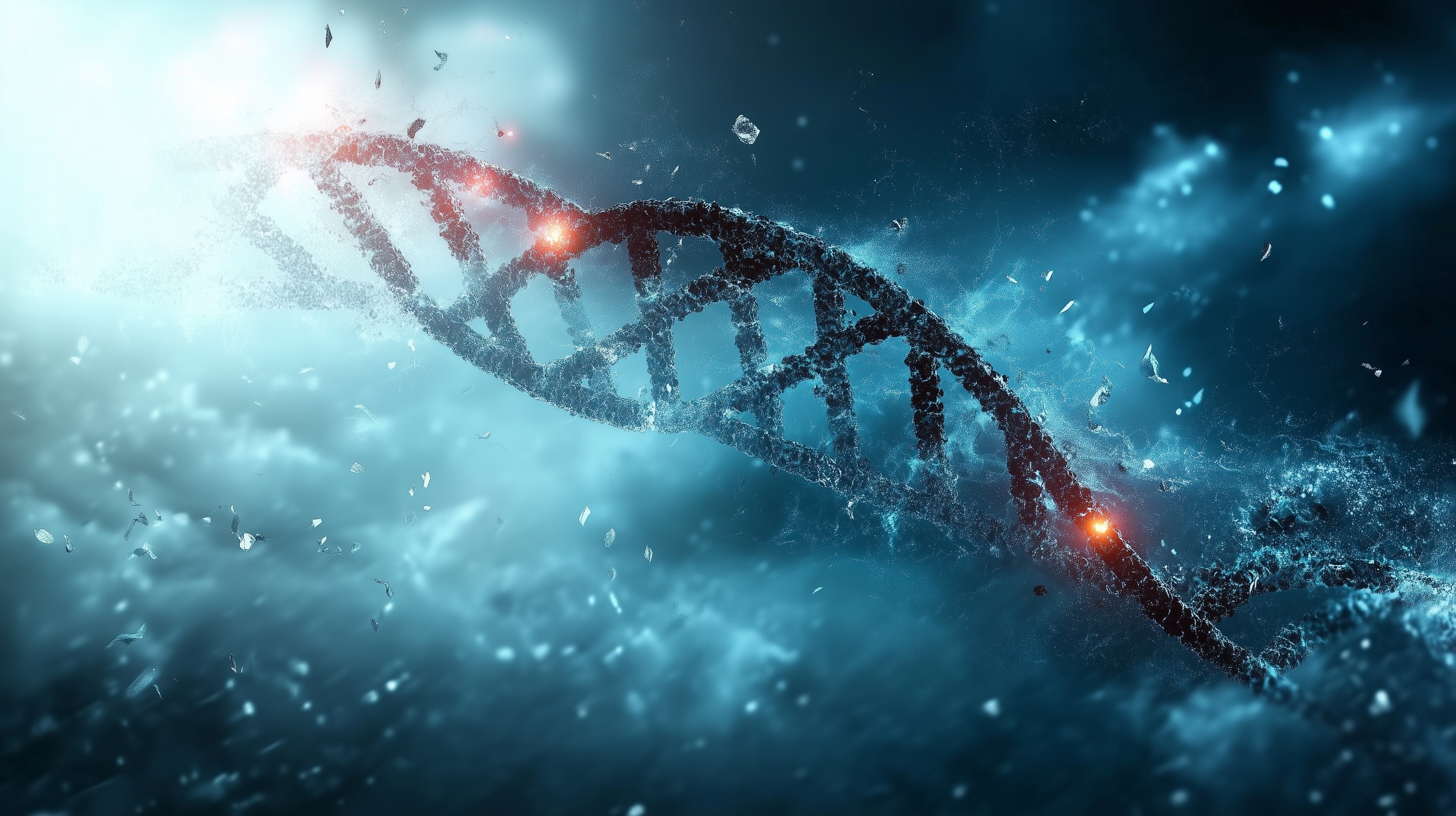Sucralose – The Sweet Poison
The serious effects of sweeteners on our microbiome and our health
The sweetener sucralose is increasingly suspected of having harmful effects on humans. But what is it really about? Is this just scaremongering, or are there study-based facts?
Beverages, dairy products, confectionery, baked goods, frozen products, seasonings, sauces, food supplements, protein shakes – the list of foods in which sucralose is used as a “sweetening substance”, i.e. as a sweetener, seems almost endless. This is because sucralose has the highest degree of sweetening of all conventional sweeteners. Compared to conventional sugar, sucralose is 400 to 600 times sweeter.
This has two major advantages: Firstly, even substances that do not taste good can be made edible with only small quantities, and secondly, the small quantities used mean that the costs are low. The food industry therefore benefits twice over.
In one kilogram of protein powder, the typical amount is between 0.1 and 0.5 grams. This means that a 50-gram serving of protein powder contains about 5 to 25 milligrams of sucralose. This may not seem like much at first glance, but it is not.
Approval process and false assumptions: What went wrong with sucralose?
When the original approval was granted by the US Food and Drug Administration (FDA) in 1998, it was based on the following assumptions:
- Stability in the body: Sucralose should pass through the intestine almost completely and unchanged and be excreted again.
- No effect on the gut microbiome: Sucralose should be inert, i.e. biologically inactive, and have no effect on the bacteria.
- No impairment of the intestinal barrier: Sucralose should have no harmful effect on the intestinal wall.
- No bioaccumulation: Sucralose should not accumulate in the body.
- No effects on glucose or insulin metabolism: Sucralose should not interact with blood glucose levels.
- No carcinogenic properties: Sucralose should not increase the risk of cancer.
Today we know: All assumptions seem to be wrong. This is confirmed by studies carried out on humans and animals.
Discovery and marketing: sucralose – a chance discovery with enormous potential
A researcher at Tate & Lyle, in collaboration with the University of London, discovered sucralose in 1976 when he mistakenly tested the compound and noticed its extremely sweet taste. The company focuses on specialty ingredients for the food and beverage industry. The enormous economic benefits were quickly recognized, and initial safety and efficacy tests were followed by an aggressive market launch of the product in the 1990s, initially under the brand name Splenda.
Natural or artificial? Sucralose compared to other sweeteners
The sweetener is considered a synthetic sweetener, in contrast to stevia, which is classified as a natural sweetener. Sucralose does not occur in nature and is produced by modifying household sugar by replacing certain hydroxyl groups with chlorine atoms. This chlorination changes the structure considerably. The FDA also classifies sucralose as an artificial sweetener.
Which form of sucralose is harmful?
Pure sucralose is already harmful, contrary to the FDA’s approval at the time. This has been clearly demonstrated in various studies. It is particularly harmful if taken over a long period of time. However, as it is used as a sweetener in so many products, it is quickly absorbed.
In addition, sucralose is partially converted into sucralose-6-acetate in the intestine. This degradation product is also present in low but relevant concentrations in commercially available sucralose. Sucralose-6-acetate is much more harmful than sucralose itself.
Interactions between sucralose and the microbiome: What happens in the gut?
There are two main interactions between sucralose and the microbiome:
Promotion of the decomposition product sucralose-6-acetate by the bacteria
This is a hypothesis that is currently being tested. Here, the microbiome would directly support the conversion of sucralose into the more harmful form sucralose-6-acetate. This seems likely, as microorganisms possess the enzymes required for this. The acidic environment of the stomach could also play a role, as could products formed by the microbiome, which could then interact with sucralose to form sucralose-6-acetate.
Direct effect of sucralose on the microbiome
The negative influence on the microbiome should be mentioned here first and foremost. Not only does it change, but studies have shown that beneficial intestinal bacteria such as Lactobacillus and Bifidobacterium in particular are specifically reduced, while the growth of pro-inflammatory bacteria is promoted. An imbalanced microbiome is the cause of many diseases and should be avoided as far as possible.
Further damage to health caused by sucralose
But sucralose and its breakdown product cause much more than a negative influence on the microbiome. Only the three most significant health hazards caused by consumption are listed below.

A. Impairment of intestinal integrity
Sucralose and even more so the breakdown product sucralose-6-acetate can weaken the intestinal wall via various mechanisms, such as oxidative stress, disruption of cell connections, inflammatory reactions and changes in the microbiome. This contributes to the dreaded “leaky gut syndrome”, in which bacteria and their toxins from the intestine enter the bloodstream.
The intestinal wall is a very important protective barrier against the large quantities of bacteria present in the intestine. If this barrier breaks down, the bacteria, toxins and undigested food components flow into the blood. This leads to a variety of health problems, such as inflammatory reactions, autoimmune diseases and a disturbed hormone balance.
The patient notices this above all through gastrointestinal complaints, tiredness, headaches, skin problems and a variety of other health problems.
Leaky gut syndrome can be detected by various diagnostic tests, as certain substances, for example, are detected in increased quantities in the bloodstream. Treatment of leaky gut syndrome is possible, but requires a holistic approach.
B. Impairment of glucose metabolism
Sucralose can influence the release of insulin from the pancreas. More insulin is released when sucralose is ingested. A prolonged excessive insulin response eventually leads to insulin resistance. As a result, less sugar is absorbed from the blood into the muscle, fat and liver cells, so that the sugar level in the blood rises. Type 2 diabetes is the result.
C. Promotion of cancer
The breakdown product of sucralose, sucralose-6-acetate, and to a lesser extent sucralose itself, have been shown in studies to have increased genotoxicity. This damages the DNA in the cells, which in turn triggers mutations and can potentially cause cancer. The sweetener also has a direct effect on the repair mechanism, i.e. cells are less able to repair DNA damage, which in principle occurs all the time. Increased mutations and cancer are the result.
Genotoxicity is probably the most drastic health side effect because it is directly relevant at the DNA level. It is important to keep this in mind once again: Here is a substance that has the potential to damage the DNA in our cells. In addition, it also inhibits the repair of the genetic damage it has caused. A truly toxic system.
What concentration of sucralose is harmful to the body?
As always, the dose makes the poison with sucralose. So the question is: can sucralose and its breakdown product be harmful to health even in normal concentrations? Can sucralose influence the microbiome? The answer is quite clear: Yes!
The genotoxic effect, i.e. damage to the DNA, is already observed at 0.15 µg/person/day. This is a value that is already exceeded in a single dose of a drink containing sucralose. In addition, both sucralose and sucralose-6-acetate bioaccumulate, i.e. they accumulate in the body over a longer period of time.
Why isn’t sucralose already banned? A look behind the scenes
The main problem is that sucralose has already been approved. Revoking this is a complex regulatory process in which many economic interests play a role as well as potential recourse claims. However, the studies for approval all took place in the 1990s, when the molecular biological methods that are used today were not yet available.

In addition, the genotoxicity experiments were carried out on in vitro cell cultures or in animal models and are therefore not comparable per se with human studies. But this is where the problem of our time becomes apparent: nowadays, cell culture studies are increasingly being demanded to replace human studies and also animal experiments for ethical reasons. However, if these “surrogate studies” show a risk, no consequences are drawn because there are no corresponding human studies.
But would you – in the case of sucralose – explicitly carry out experiments on humans? And is it not sufficient if concentrations that are common when consuming sucralose show damage to DNA in cell cultures and animal experiments? Is there really a need for a transfer to humans, which is unlikely to take place in this form for the reasons mentioned above?
A negative conclusion is drawn: Consequences are only drawn when there is proof in human studies, which are not carried out because negative consequences are to be feared. Nothing happens until then! Sucralose will continue to be allowed and people will be put at risk. Cancer rates will continue to rise, and since cancer has multifactorial causes and can rarely be attributed to a single cause, the statistics show an increase in cancer – but a ban on sucralose is unlikely to happen anytime soon given the FDA approval that has already been granted and the lobbying efforts of the corporations. The ones who suffer are the – uninformed – consumers.
Why are there actually sweeteners?
But once again, the problem lies deeper. The use of sucralose and other sweeteners is just one response to the market. It is a symptom and not the cause. The problem is the consumer’s desire for everything to taste as “good” as possible, in other words sweet. The extent to which the food industry has educated consumers to do this is not a matter for discussion here. However, the fact is that consumers are not prepared to compromise: Nutrition should be low in calories and still be tasty.
It is easy for the industry to make a tasteless product such as a sugar-free juice or a protein mix with sucralose taste more pleasant. And it does so because otherwise its products would not be accepted by most consumers, who in turn have become accustomed to the sweetness in food as a result of years of sugar use in high concentrations by the food industry.
This vicious spiral must be broken. And this can only happen through independent education. (JS)
____________________
Further reading:
Romo-Romo et al. (2018):
Romo-Romo, A., Aguilar-Salinas, C. A., Brito-Córdova, G. X., Gómez-Díaz, R. A., & Almeda-Valdes, P. (2018). Sucralose decreases insulin sensitivity in healthy subjects: A randomized controlled trial. American Journal of Clinical Nutrition, 108(3), 485-491. doi: 10.1093/ajcn/nqy152.
Pepino et al. (2013):
Pepino, M. Y., Tiemann, C. D., Patterson, B. W., Wice, B. M., & Klein, S. (2013). Sucralose affects glycemic and hormonal responses to an oral glucose load in obese subjects. Diabetes Care, 36(9), 2530-2535. doi: 10.2337/dc12-2221.
Li et al. (2020):
Li, X., Liu, Y., Wang, Y., Li, X., Liu, X., Guo, M., … & Jiang, M. (2020). Sucralose promotes colitis-associated colorectal cancer risk in a murine model along with changes in microbiota. Frontiers in Oncology, 10, Article 710. doi: 10.3389/fonc.2020.00710.
Bian et al. (2017):
Bian, X., Chi, L., Gao, B., Tu, P., Ru, H., & Lu, K. (2017). Gut microbiome response to sucralose and its potential role in inducing liver inflammation in mice. Frontiers in Physiology, 8, Article 487. doi: 10.3389/fphys.2017.00487.
Schiffman & Rother (2013):
Schiffman, S. S., & Rother, K. I. (2013). Sucralose, a synthetic organochlorine sweetener: Overview of biological issues. Journal of Toxicology and Environmental Health, Part B, 16(7), 399-451. doi: 10.1080/10937404.2013.842523.
Schiffman et al. (2023):
Schiffman, S. S., Scholl, E. H., Furey, T. S., & Nagle, H. T. (2023). Toxicological and pharmacokinetic properties of sucralose-6-acetate and its parent sucralose: In vitro screening assays. Journal of Toxicology and Environmental Health, Part B, 26(6), 307-341. doi: 10.1080/10937404.2023.2213903.



